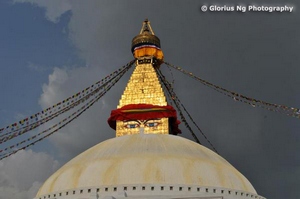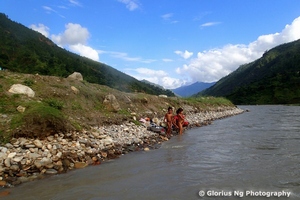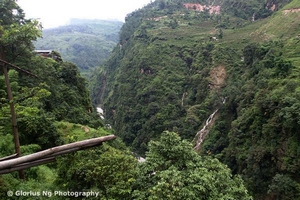Home > Asia > Nepal > Trekkings



Trekking in Nepal
Among the many tourist adventure activities in Nepal, trekking is by far the most popular. The diversity in Nepal's nature and a range of exotic culture makes this country ideal for trekking. Trekking in Nepal provides an opportunity to observe the local culture of people and enjoy the beauty of nature undisturbed by influence of modernity. You can choose between fully organized trekking and independent trekking depending on the situation.
Trekking Areas
Everest region :-
The Everest region is located in the northeast of Nepal. The most visited part of this region is Solukhumbu district, home of the legendary Sherpas and the highest peak of the world, the Mt. Everest at 8,848 meters. To the norht of Solukhumbu is Everest National Park, while to the east is the Makalu Barun National Park. The major ethnic groups that live in the Everest region are Sherpas, Rais, Tamangs, Brahmins, and Chhettris. Diverse range of wildlife and vegetation are seen in the region. Animals tobe sighted are mountain goat, musk deer and barking deer in the forests. Birds includes Impeyan Pheasant (Danfe), ravens, crows, choughs and snow pigeons. The best time to visit in spring and autumn.
Popluar trekking areas are Everest Base Camp, Gokyo Valley, Lukla, Pike Danda, Dudh Kunda, Salleri, Chiwong Circuit, Hinkhu, Hongu Valleys and Everest to Aurn Valley. Interesting landmarks near Syangboche are Khumjung School built by Sir Edmund Hillary in 1961 and Khunde Hospital norht of Namche Bazaar established in 1968. How to trek in the Everest region depends on the route chosen. Teahouse trekking is possible on the main trail to Everest Base Camp or the route up the Gokyo Valley. The trail from Jiri to Lukla also has teahouse on the way.
Annapurna region:-
The Annapurna region lies toward the north of central Nepal. The region has been recognized as one of the world's best trekking trails. The highlights of this part of Nepal are Annapurna Peaks, Mt Dhaulagiri, river Kali Gandaki and several other peaks. Gateway to Annapurna trekking region is the famous city of Pokhara. The most prominent ethnic groups of Annapurna region are Gurungs and Thakalis. Animals found here are pika, blue sheep and Himalayan Tahr and vegetation ranges from tropical species to temperate forests of oak, beech and rhododendron.
The popular trekking routes of this region are Jomsom, Annapurna Circuit and Annapurna Base Camp, Annapurna foothills, Sikles, Lamjung, Dhaulagiri, Upper Mustang and around Pokhara. The best time to visit is during spring and autumn. Unlike other parts of Nepal, even the monsoon months are ideal to vsit upper Mustang that falls in the rain shadow area. Most trekking routes in the Annapurna region are well serviced by teahouses. Trekkers should , however, be careful while trekking to the more remote parts of the region.
Langtang area:-
Lantang area, is toward the north of Kathmandu Valley. The scenery here is spectacular, and the trek more adventurous as the area is visited by fewer tourists. To the west of Langtang is Ganesh Himal with a range of 6,000 to 7,000 meters. The main ethnic groups living here are Sherpas and Tamangs. The forests in the region have temperate and sub-alpine vegetation. Wildlife include migratory birds, deer, Monkeys, Tahr and Pika. The best time for trekking in the Langtang area is spring and autumn. Most of the trekking routes in Helambu and Langtang are well served with teahouses making independent trekking quite impossible. But, there are no such facilities in the Ganesh Himal area or Ganja La area.
Gorkha and Manaslu:-
The area to the east of the Annapurna are the peaks of Manaslu group. Few visitors trek to this area, whcih makes a visit here all the more unique and unspoiled. The area is bordered by River Budhi Gandaki and to the west by River Marshyandi. This area is marked by two cultural highlights: Gorkha, which is the ancestral seat of the reigning Shah dynasty and the temple of Manakamana. Since the treks in the Manaslu region orginiate at around 1,000 meters and reach a high as 5,200 meters, the trekker will see a wide range of flora typical of the middle hills and alpine regions of Nepal. Plants to be seen around here are pine, rhododendron, wildlife include barking deer, pika and Himalayan marmots. Birds to be sighted in the region are pheasant, raven and chough. People of Tibetan origin inhabit several villages. Other groups found here are Gurungs and Tamangs. The best time to trek here is between September and May. A few teahouse are seen in the Manaslu Conservation Area, however, teahouse trekkingis not a suggested option. Government regulations require all the group trekkings to the Manaslu Circuit to be fully sufficient.
The far east:-
The far-east region of Nepal provides unique treks along rarely visited trails. One of the main attraction is the spectacular scenery of rhododendron in bloom on the hills and ridges along the way. Deer and wild sheep are often spotted in the area and birds are found in abundance. The region is home to ethnic groups notably the Rais and Limbus. The popular trekking areas in this region are Kanchenjunga area, Milke Danda and Jaljale Himal. In general, the region has not been developed to cater to independent trekkers, so groups must be fully self sufficient.
The west:-
Treks in the west of Nepal are quite different from treks in the other parts of the country. The region is less developed and has fewer facilities available for the visitors. This makes trekking here much more of an exploration type and intending trekkers must be prepared for some delays and other hardships. It is also considerably more expensive to trek in the remote parts of the west. Ethnic group of people seen in the northern parts of the area, particularly in Dolpa, are of Tibetan origin. Other groups found here are Magar, Gurung, and the people of Hindu caste origin. Commonly seen animals are leopard, HimalayanTahr and blue sheep.
Popular trekking areas in this region are Dolpa, Simikot and Lake Rara. The best time to visit is the traditional trekking seasons of spring and autumn. The northern parts are also suitable for summer treks. The region has not been developed to cater to independent trekkers, so all groups must be self-sufficient, in all respect.
Lower dolpa and upper dolpa:-
Located in the central west of the country, the focal point of the area is the Shey Phoksundo National Park. This remote and rugged protected area is both scenically and culturally attractive. The Lower Dolpa trek circuit can be completed in eight days from Juphal back to Juphal. The circuit can be completed either clockwise or anticlockwise, depending on preference but in both cases the focal points of the trek are Phoksundo Lake and the Tarap Valley.
In comparison to lower Dolpa, less number of trekkers enter the restricted upper Dolpa section of Shey Phoksundo National Park. The main attraction of the area is the wild and pristine landscape. Geographically, it is similar to Tibetan Plateau and is generally dry, cold and sparesely vegetated. The trekking season for both Upper and Lower Dolpa is generally from June to September.
Humia and Jumia:-
The trek from Simikot, the administrative center of Humla District, to the Tibetan border is usually used to reach western Tibet, where Mount Kailash is the major attraction. Tourism related facilities are relatively undeveloped in this area although several organizations are working to promote community based tourism opportunities between Simikot and the Tibet Border. The only way to reach Simikot is to fly from Nepalgunj or to trek from Rara Lake- the largest lake in Nepal. The area surrounding the lake is Rara National Park. Schedule flights to Simikot are generallly unreliable due to weather conditions but large groups have the option of chartering flights.
The most common way to get to Rara is to take a flight from Nepalgunj to Jumla, from where it is two to three day trek to the park. An alternative way is to combine a trek to lower Dolpa and a visit to Rara National Park. By trekking west from Dolpa it is possible to reach Jumla and the park within a week. It is advisable to consult government registered trekking agencies before trekking to this region. The best way to trek here is in group through a good trekking agency.
Trekking around palpa:-
The ancient town of Tansen is the headquarter of Palpa district. It is located about 7 kilometers northwest of Bartung in Siddhaartha highway. Tansen is famous for historical monuments, temples and lively handicraft industry. There are a number of short treks possible around Tansen that take the trekkers to local sites of scenic and cultural interest. The best short trek from Tansen is probably the circuit to Ranighat, on the banks of River Kali Gandaki. There are basic teahouse at Ranighat and camping on the beach is also possible. Another attracitve short trek suitable in the wintertime is to follow the old trade route from Tansen, down to Sisnu Khola and end in Butwal. Another popular trekking route is the Dhorpatan Circuit. Food and accommodation facilities are available at Tansen.
Trekking in and around Kathmandu Valley:-
Kathmandu Valley offers excellent short treks. Some of these treks can be even completed in one day. It is also possible to turn the treks into overnight trips. Some popular treks around Kathmandu are Shivapuri area, Sundarijal to Budhanilkantha, Godavari to Phulchowki, Kirtipur to Champadevi, Nagarjun, Nagarkot to Changu Narayan etc. Permit is required for trekking around Shivapuri National Park.
All information above are given for reference only. They are subject to change without giving prior notice.
|
|---|
Newsletter Subscription: 訂閱最新旅遊資訊
Site Map · Privacy Policy 私隱政策(只附英文版)
© 2020 Exotic-Holidays.hk · All Rights Reserved.
![]()